Updated March 2, 2023
If you’re interested in following the race online, see: NTV (Nippon TV) Hakone Ekiden site
I. Overview
The Hakone Ekiden 箱根駅伝 is a 2-day relay-race between teams of elite male runners from Japanese universities. The race takes places annually on January 2nd and 3rd, and dates back to 1920. The upcoming (2017) race will be the 93rd edition of this proud tradition (a few years were missed due to WW2 and its aftermath). The race is nationally televised in Japan and viewed by around 28% of the country.
The race is divided into 10 stages, five ‘outward’ or ‘forward’ 往路 stages on Day 1, and five ‘return’ 復路 stages on Day 2. Each leg of the race is run by a different runner, and exchanges are made at designated relay points.
Day 1 starts in Otemachi, in front of the Yomiuri Shimbun (newspaper) building, and finishes 108.0 km (67.1 miles) away at Lake Ashi 芦ノ湖. As well as being a popular viewing spot for Mt. Fuji, the Day 1 finish line is home to the Hakone Ekiden Museum 箱根駅伝ミュージアム (map). Day 2 starts where Day 1 finished, and retraces the course from the previous day, with minor deviations.
Each of stage of the race is approximately 22 kilometers (13.5 miles), with runners finishing in roughly 1-hour (a pace of 4:45 minutes per mile). The exception is the brutal 5th stage, which climbs almost 900 meters into the hills of Ashinoyu 芦之湯; the fastest ever pace for this leg is 5:25 minutes per mile.
II. Route
Hakone Ekiden course map (source):
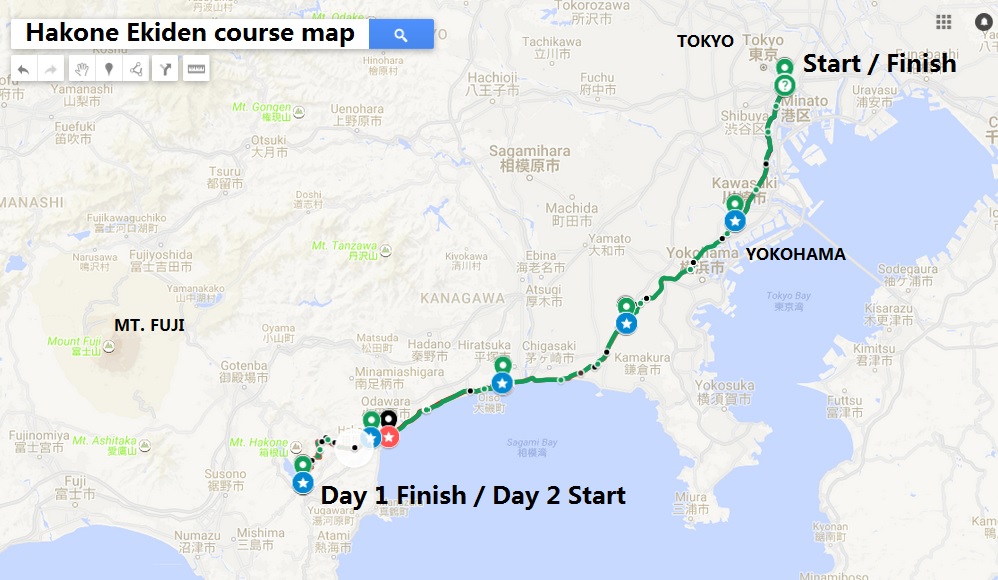
The course generally remains the same from year to year. The start, finish, and transition points are as follows:
Day 1:
Start: Otemachi, north side of the Yomiuri Shimbun Building 大手町・読売新聞東京本社 (map)
End of stage 1: Tsurumi relay station 箱根駅伝 鶴見中継所 (往路) (map)
End of stage 2: Totsuka relay station 箱根駅伝戸塚中継所 (往路) (map)
End of stage 3: Hiratsuka relay station 平塚中継所 (往路) (map)
End of stage 4: Odawara forward relay station 箱根駅伝 往路 小 (map)
End of stage 5: Lake Ashi goal 箱根駅伝 芦ノ湖ゴール (map); next to the Hakone Ekiden Museum 箱根駅伝ミュージアム
Picture of of the starting line of the Hakone Ekiden 箱根駅伝スタートライン(往路出発点):
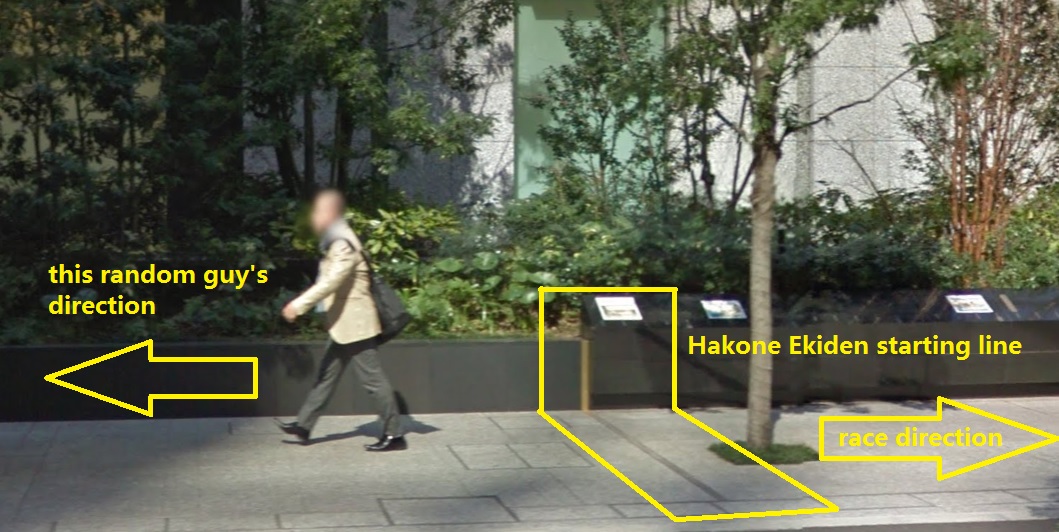
Here’s a photo of the Tsurumi relay station 箱根駅伝 鶴見中継所, the transition for the first leg of the race (map):
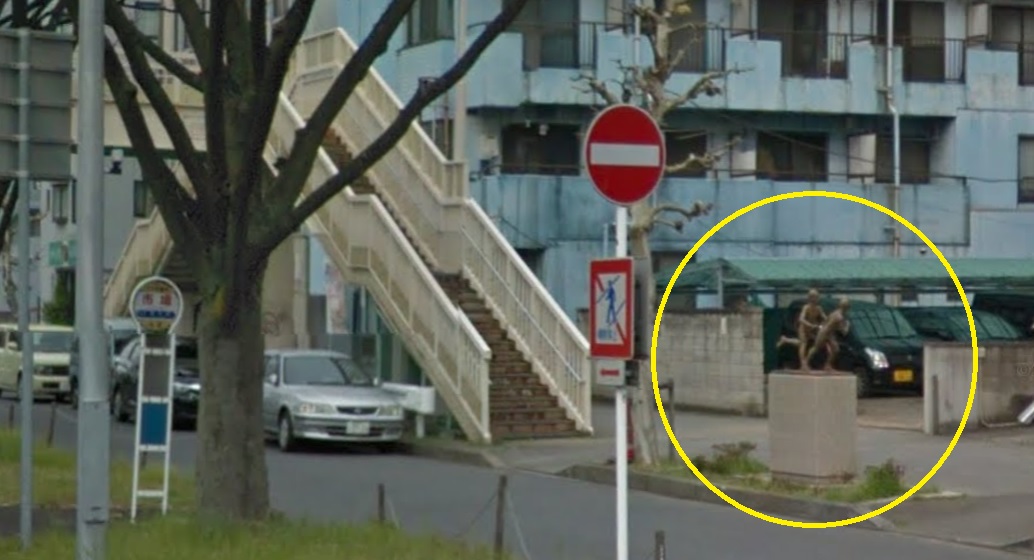
Day 2:
Start: Lake Ashi start 箱根駅伝 芦ノ湖スタート (map)
End of stage 6: Odawara relay station 小田原中継所 (map)
End of stage 7: Hiratsuka relay station 平塚中継所 (復路) (map)
End of stage 8: Totsuka relay station 箱根駅伝戸塚中継所 (往路) (map)
End of stage 9: Tsurumi relay station 箱根駅伝 鶴見中継所 (復路) (map)
End of stage 10 [FINISH]: Otemachi, south side of the Yomiuri Shimbun building (between exits C3 & E1 of Otemachi Station) (map)
Hakone Ekiden finish line, with list of winning teams (箱根駅伝歴代優勝校銘板)
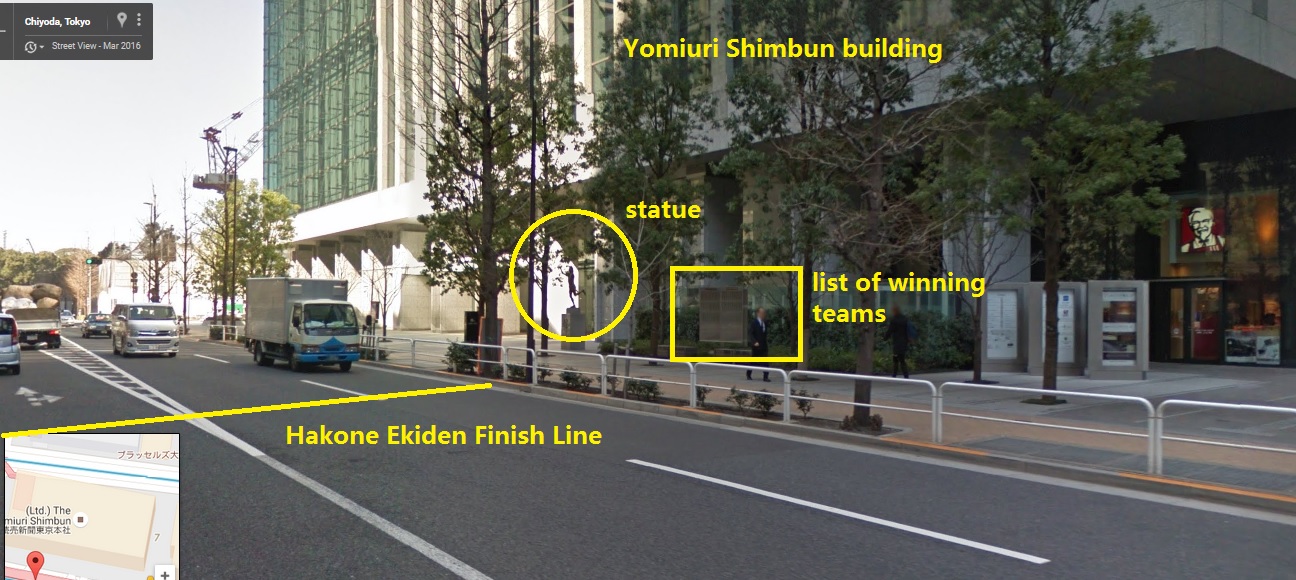
The following is a map of the course, which includes the location of the relay-points, and includes the estimated times at which the lead runner will pass by various points along the course:
III. Rules
The full rules (in Japanese) include details such as the distance within which the tasuki タスキ relay sash must be passed after crossing the relay line (its 20 meters). For the the casual viewer, the most important rules are:
(1) The top 10 team qualify for the next year’s race
Qualifying for the Hakone Ekiden is a great achievement; in 2016, some 50 teams competed in the Hakone Ekiden Yosenkai 回箱根駅伝予選会 (qualifier) race, with the top 10 schools qualifying for the Hakone Ekiden. The other half of the field is made of the top 10 teams from the previous-year’s race. This is one of the best features of the Hakone Ekiden, as it motivates teams in the middle of the pack to run their hardest, which is especially evident on Day 2. This is nicely expressed by the Mindanao Examiner, “As always, joy and sorrow surrounded the top 10 finishers, who automatically secure a slot at next year’s Hakone Ekiden.”
(2) Starting order on Day 2 復路のスタート (Return-path start) (Chapter 5: Article 20)
Day 2 of the race has a staggered start ‘時差出発’, with the previous-day’s winner starting at 8:00 a.m. and subsequent teams starting with time delays according to the prior-day’s results. Teams that finished more than 10 minutes behind the first-place team on Day 1 all depart at the same time on Day 2 at 8:10 a.m. (a ‘simultaneous departure’ ‘同時出発’). The remaining time differential over 10 minutes is tracked and added to the team’s final results.
(3) Advance start 繰り上げ出発 / 「繰上げスタート 」, a.k.a the “20-minutes behind” rule (Chapter 5: Article 19)
As the race progresses, the gap between the fastest and slower teams continues to grow; teams that are more than 20 minutes behind the first place team are forced to have their next runner depart the relay station while the current runner is still on the course. The departing runner is forced to wear a specially-colored sash to indicate that this runner did not receive the original sash from his teammate.The time differential between this “advance start” and the finish of the previous runner is added to the team’s overall time at the conclusion of the race.
[Note: in certain stages of the race (I believe only on Day 1 of the race), the 20-minute rule is actually a 10-minute rule.]
IV. What to watch for
As I’ve written in a previous post, by the end of Day 2 there is not much drama in the race for first place. The eventual winner has been in first place after stage 8 in ten of the last twelve years, and has been in first place after stage 9 in all of the past twelve races. This hardly means the race is boring, as there are plenty of things to cheer for on both days of the race. As mentioned above, the race for the 10 automatic qualifying spots in next-year’s race is quite competitive. And also”
(1) Fastest times for each stage 区間賞 ‘section awards’
One thing to cheer for are the individual stage-winners; these runners often come from the top teams (naturally) but can occasionally come from lower-tier teams. For example, in 2015 the winner of the 10th stage was 寺田博英 Hirohide Terada from 城西大学 Josai University, which placed 7th overall.
(2) The race against the clock
As explained above, teams that fall 20 minutes behind the lead team are forced to depart prior to the hand-off. This “20-minute” rule provides a great deal of drama for viewers of the race, especially on Day 2, as the field spreads out. Runners are greatly motivated to avoid the “advance start”, and viewers count the seconds anxiously as runners near the relay line. Japanese TV broadcasters use the expression “advance of regret” 「無念の繰り上げ」 to describe the moment when a runner fails to reach the relay point before his teammate departs. My favorite part of the 2016 Hakone Ekiden was when one runner narrowly failed to reach the relay point before his teammate departed. This moment was captured by Twitter user @zaki_hmkc:
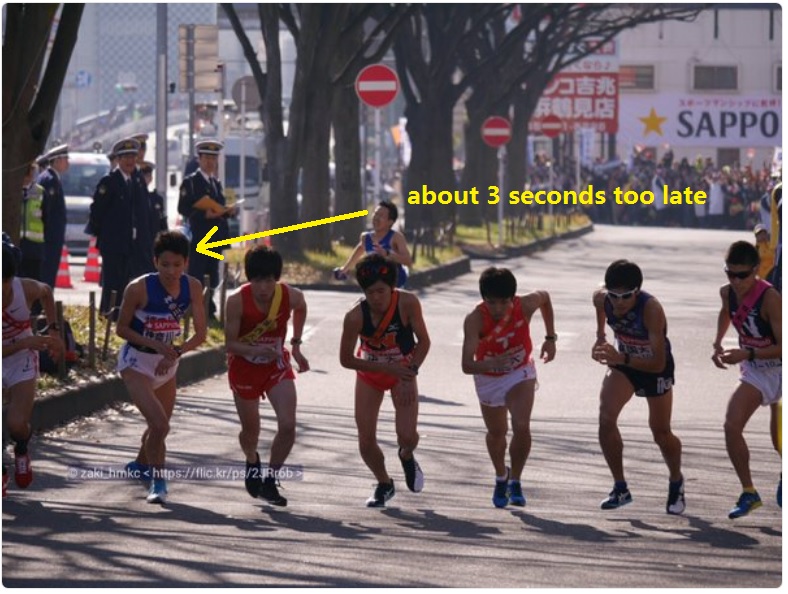
(3) Feel the burn! (Pain is fun to watch)
One of the classic things to watch for is runners hitting the wall and collapsing (or nearly collapsing). This combines a natural human interest in watching people suffer with the Japanese love of effort and perseverance (the ganbatte 頑張って spirit and all that).
(4) The unexpected
As in all sporting events, it’s the unexpected that holds our attention. In this famous clip, a group of runners fight for one of the few remaining spots in the top 10. The runner at the front of the group follows a TV van; the other runners keep going straight. See for yourself who made the right choice:
V. Where and when to watch
The easiest way to watch the Hakone Ekiden is on television. Additionally, you can track the runners online in real-time. But if you’d prefer to watch the race in person, I have a few suggestions based on my experience watching the 2015 race.
First, let me share with you a timetable that I prepared and used when watching the race. It lists the fastest legs of each race ever won, thus estimating the earliest time that the lead runner would be expected to appear at any of the transition points. I found this chart was an invaluable reference for watching the race.
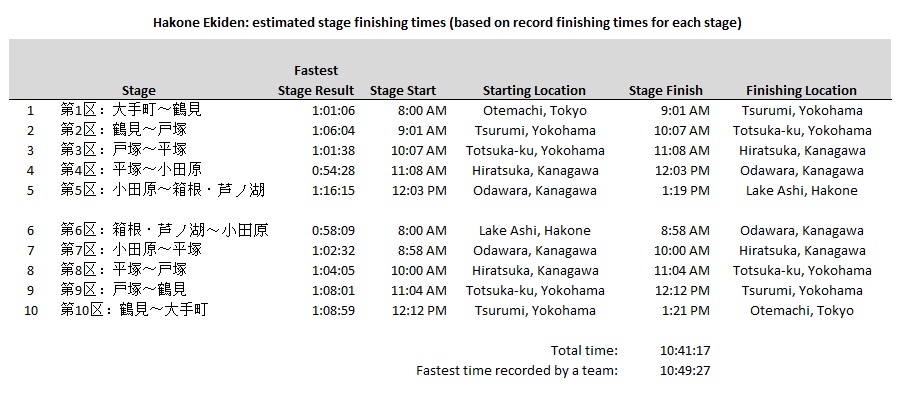
Website tracking the progress of each runner:
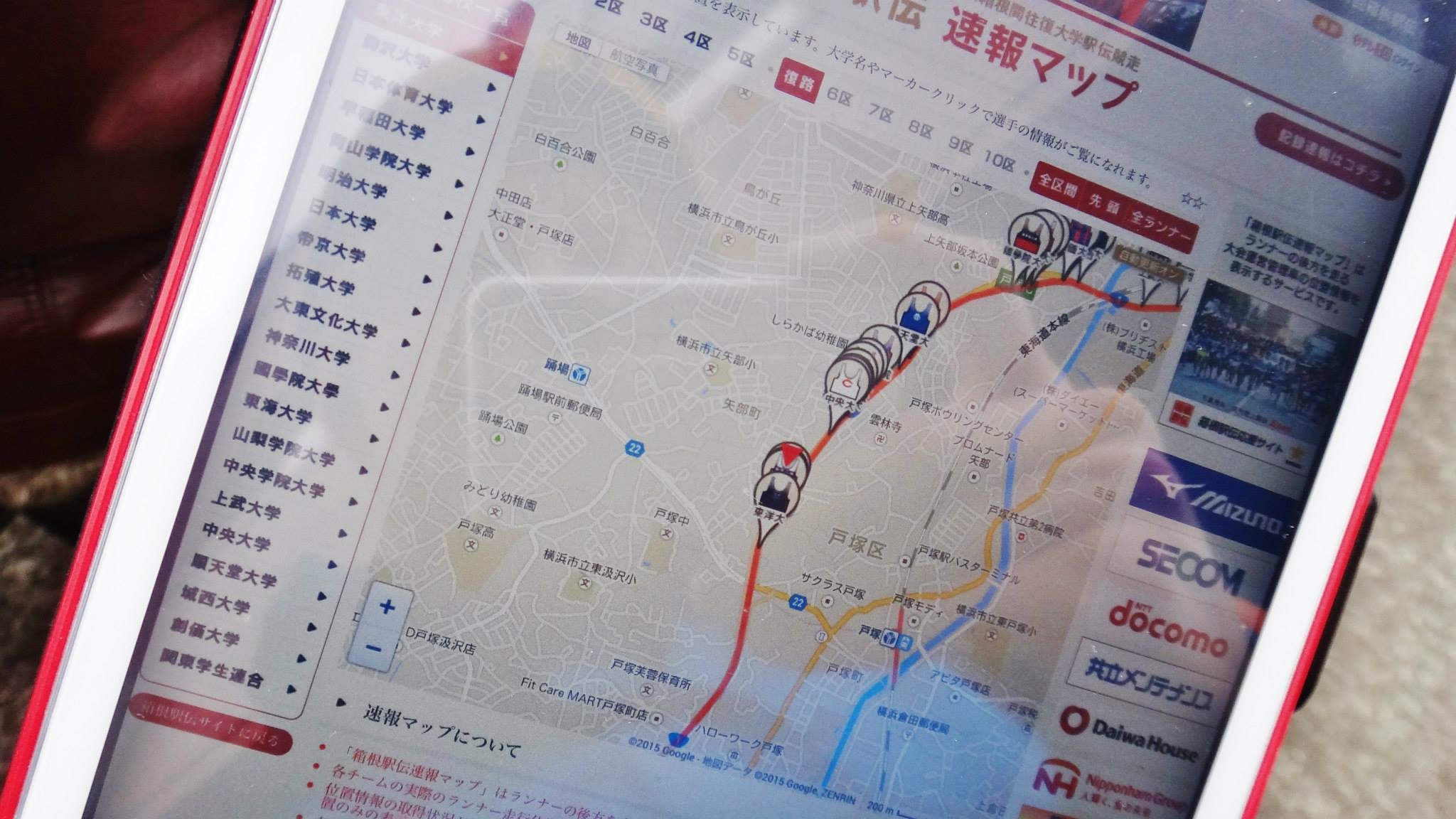
Our initial plan was to follow the race by train, stopping once per each leg of the race. However, this is difficult in reality. As I’ll describe, on Day 1 we were only able to watch the race in three locations, which were:
(I) Tokyo station
We stood along the course near Tokyo Station, not long after the runners had started. We had planned to follow-along by train to the 1st transition point, but were surprised that we wouldn’t be able to reach the Tsurumi relay station before the runners. According to Google Maps, it takes 46 minutes to take a train (including walking time) from the start of the race to the Tsurumi relay station; in comparison, the fastest runners travel this distance in 61 minutes, a cushion of just 15 minutes if you leave IMMEDIATELY after the start of the race. My friend and I decided to bypass the 1st relay point and headed to the second relay station.
Tokyo Station near the start of the Hakone Ekiden, and a glimpse of the racers (they’re very easy to see…I just took some bad photos!)


(II) Transition point 2: Totsuka relay station 箱根駅伝戸塚中継所
The second transition point is along a wide road, 2.2 kilometers from Totsuka Station. Far from the relay point the highway was lined with supporters of the race, and the crowds grew thicker as we approached the relay point. We stood along the long, gradual hill that leads up to the transition point; we enjoyed watching the lead runners struggle towards their teammates, but we never actually saw them hand-off their sashes. We moved closer to the transition point but were still unable to see the hand-offs because the thick crowds. If you plan on watching the ekiden at a relay point, make sure you get there early.
Scenes from the Totsuka relay area:


(III) Hakone-Yumoto station 箱根湯本駅 (map)
After trying to watch the 2nd relay point, we decided to make our way to the somewhere along the hilly 5th stage. Again, we were surprised by how difficult it was to move faster than the runners. We took a decently fast train to Odawara Station, but in Odawara we were met with a distressingly long line to board the Hakone-tozan Line towards Hakone-Yumoto station.
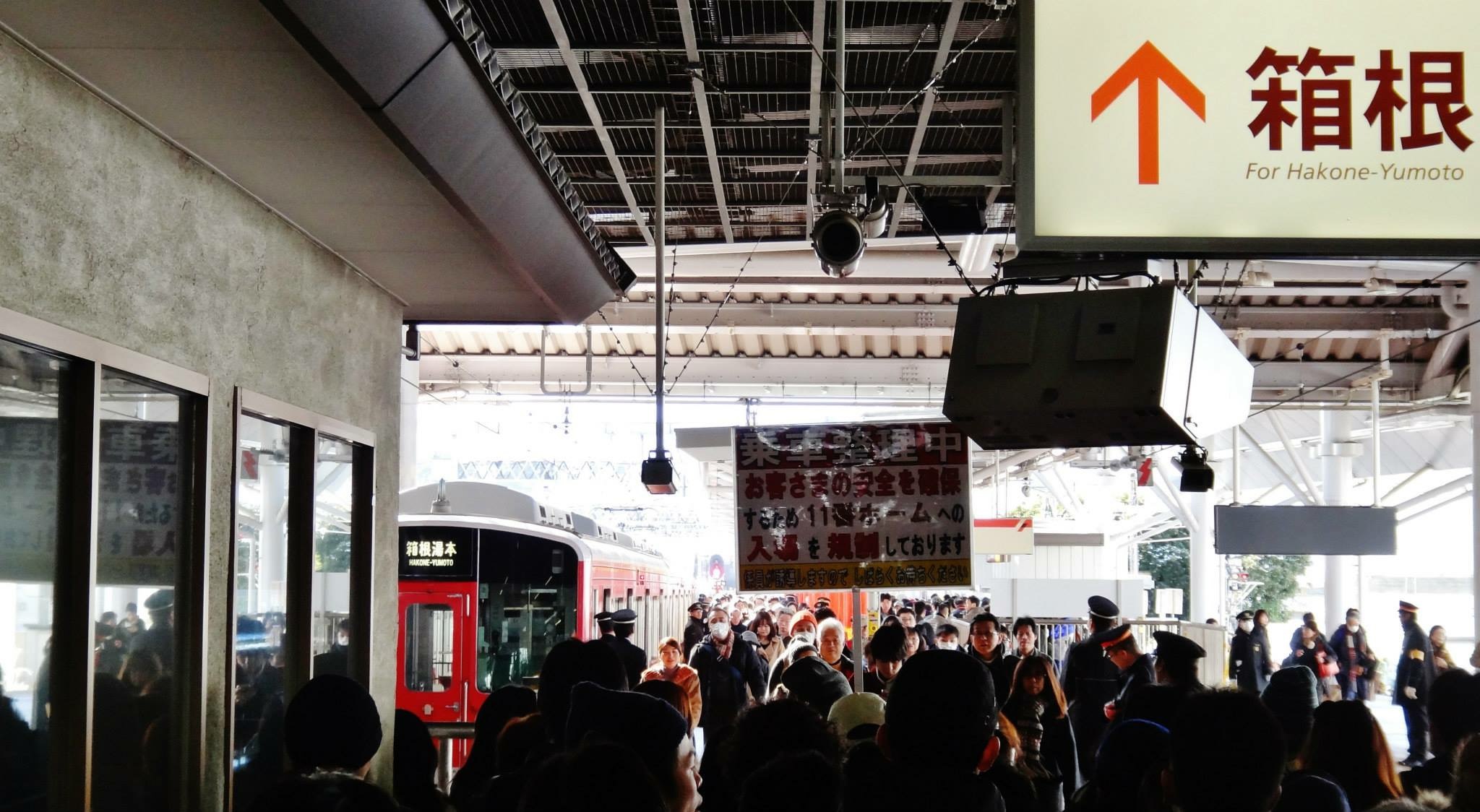
The long lines meant that we were way behind schedule, and I could tell that, according to my timetable, we were likely not to see the runners again the rest of the day. After finally boarding the train, we left the station and were pleased to still see spectators lining the roads. The train followed the ekiden route closely, and a wonderful moment of the day was when we spotted the runners below us; the train erupted into cheers and, for once, I was glad that our we had suffered many delays that day.


By the time we reached Hakone-Yumoto station, we thought the day was over, but yet again we were treated by the unexpected appearance of the runners – this time we cheered for them from our convenient perch on the train platform.


Hakone-Yumoto station is the last station on flat ground; from here the Tozan Line follows a steep grade and performing switchbacks up the mountain. Under ideal circumstances we would have had difficulty catching the runners – and now, under heavy delay, we had no chance. After almost an hour we settled into a soba shop at the top of the hill, near Gora Station. We were pleased to watch on TV as some of the top competitors completed Day 1 of the ekiden.
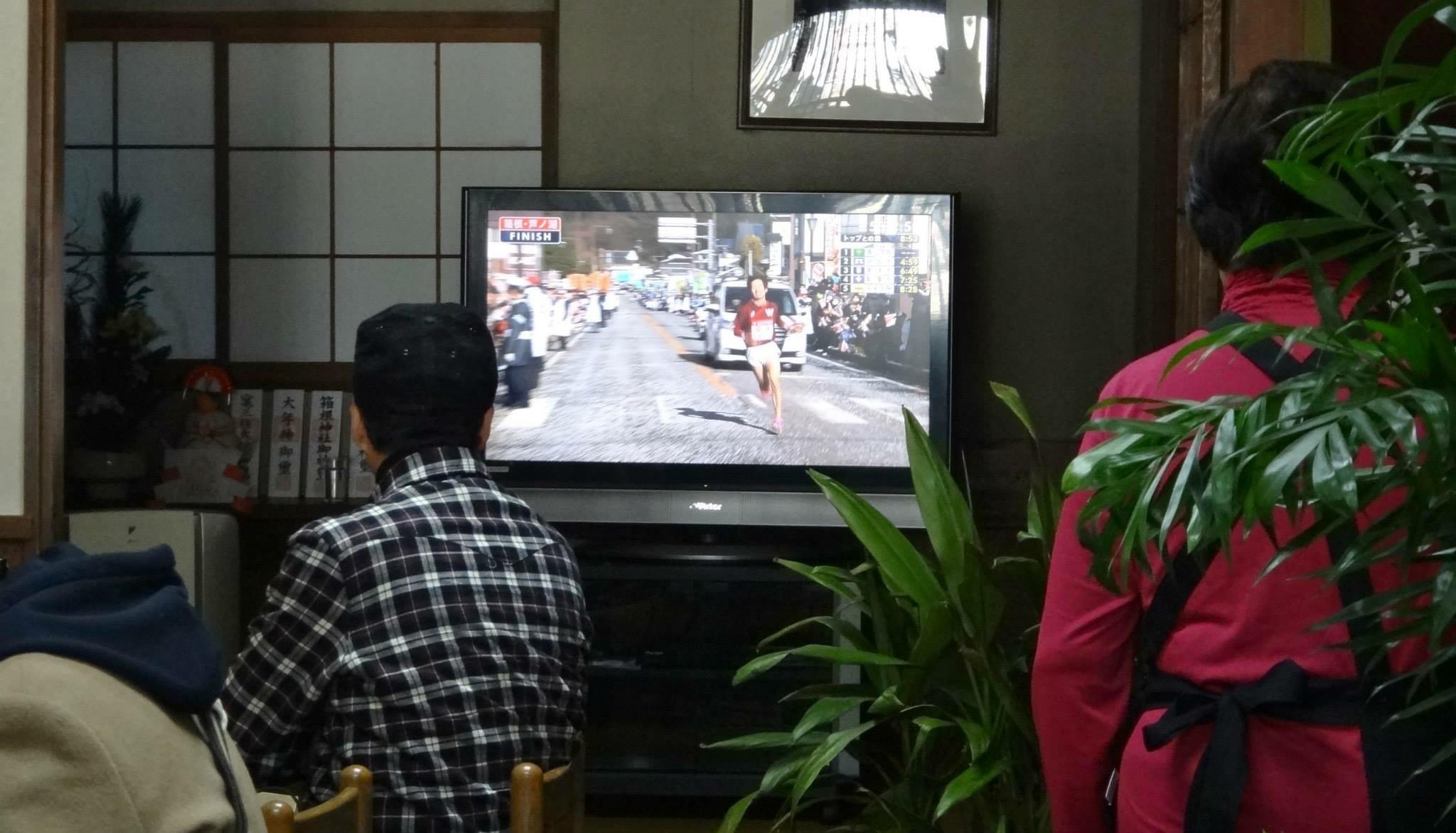
VI. Postscript
Day 2 was much less stressful because we started in the Hakone hills and only attempted to watch the action in one other location.
The downhill portion of Stage 6, the first stage of Day 2:



Sharing a ride on the Hakone Tozan Line with one of the Hakone Ekiden race teams:

In front of Zojo-ji temple, near 増上寺 Daimon station, and in the shadow of Tokyo Tower:
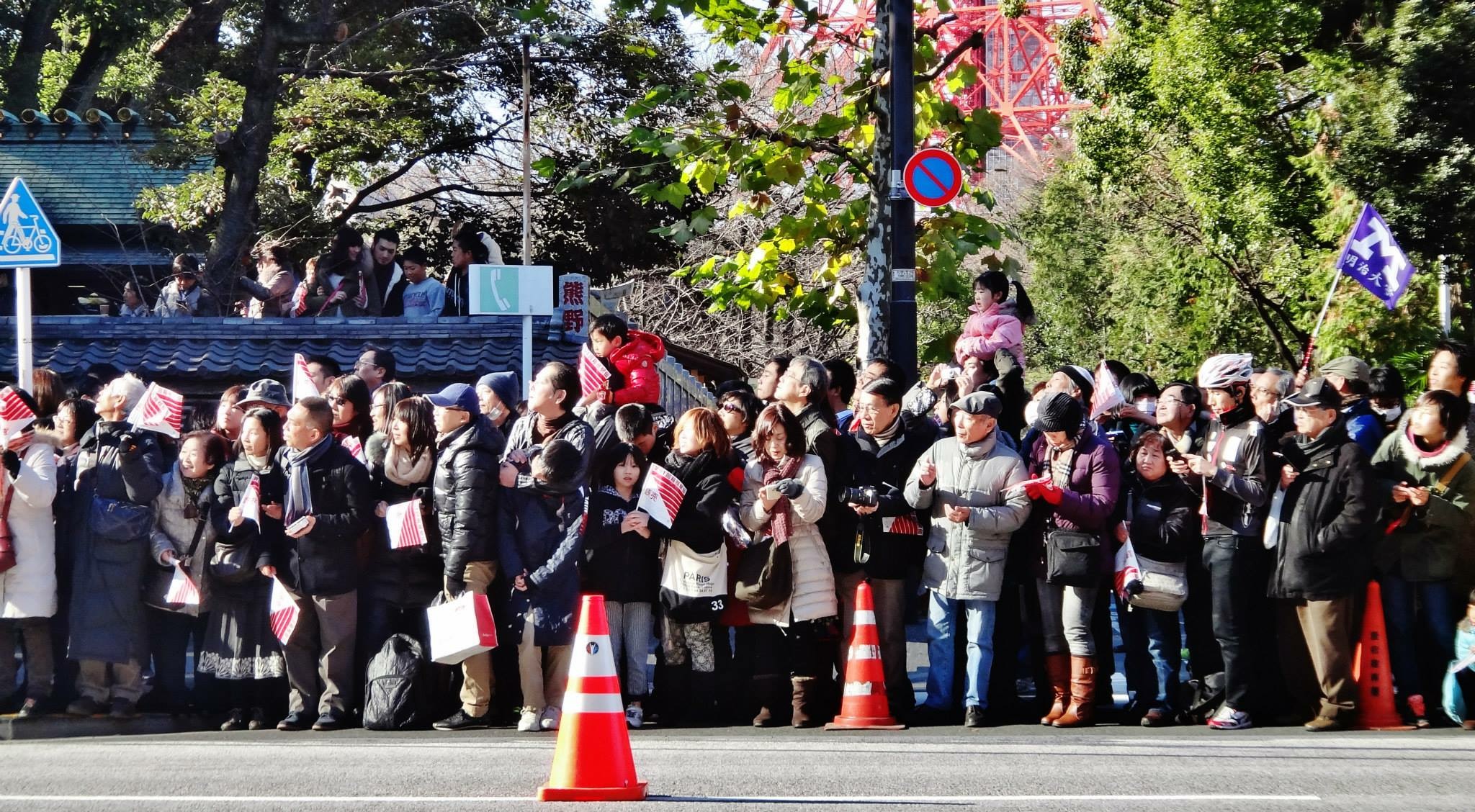
and…
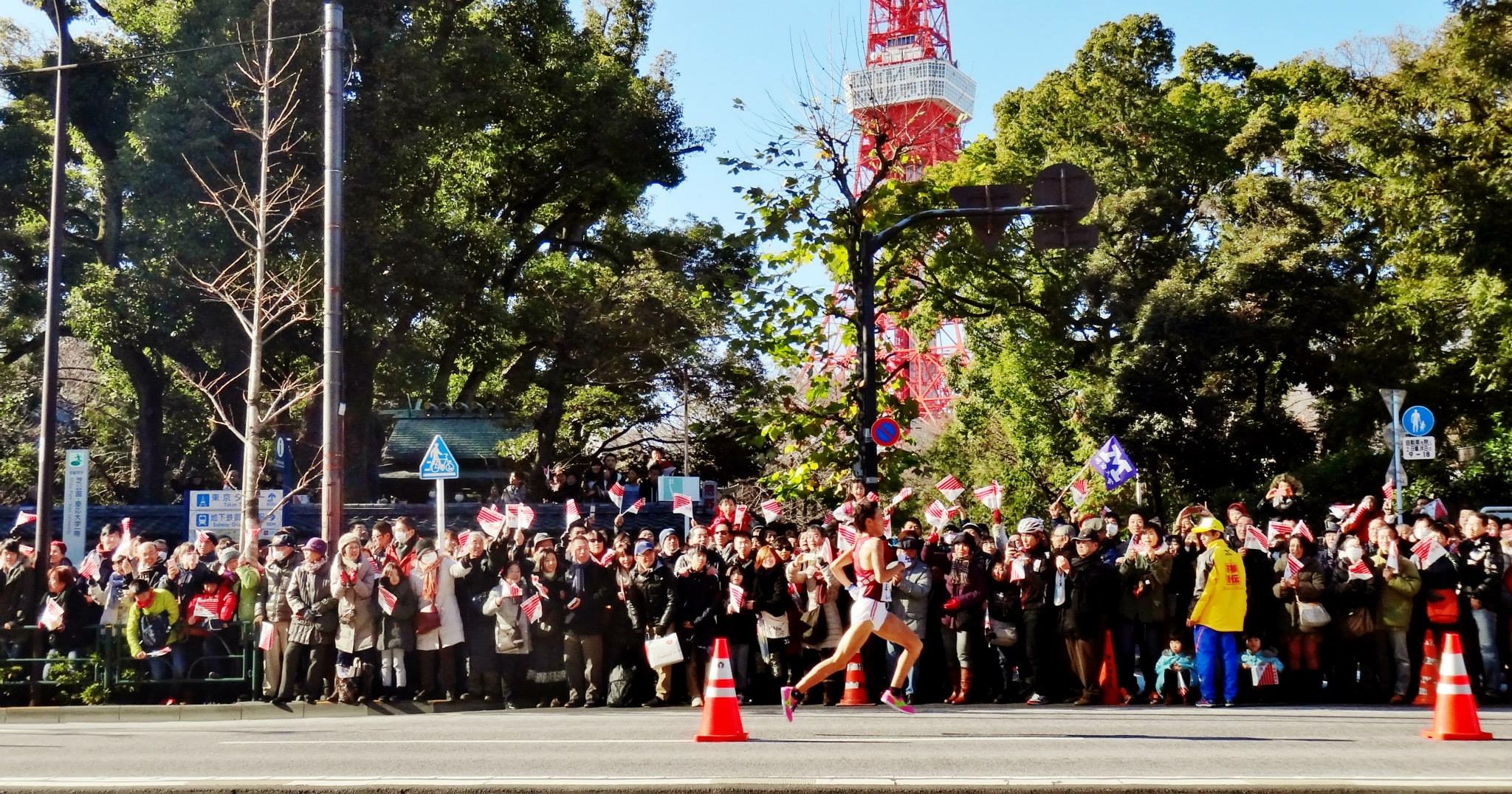
Notes:
This post was cited in a University of British Columbia master’s thesis, Ekiden Racing: Examining the Intercultural Sporting Experience of Canadian Elite Runners in the Japanese Context (PDF)
Links:
- The best site for English-language information on the Hakone Ekiden, and Japanese running in general, is Japan Running News; here is their account of the 2016 ekiden: Aoyama Gakuin University Leads Start to Finish To Win 2016 Hakone Ekiden (Japan Running News, January, 2016)
- Hakone Ekiden, Japanese Wikipedia 東京箱根間往復大学駅伝競走
- Wikipedia: 92nd Hakone Ekiden 第92回東京箱根間往復大学駅伝競走 (2016)
- Wikipedia: 91st Hakone Ekiden 第91回東京箱根間往復大学駅伝競走 (2015)
- Official results, 2016 (92nd Hakone Ekiden) (PDF)
- NTV (Nippon TV) Hakone Ekiden site
- Winning the Hakone Ekiden: greatest comebacks, 1986-2016
- Hakone Ekiden rules: 東京箱根間往復大学駅伝競走に関する内規 Internal regulations on the Hakone Ekiden Tokyo
- Photos of the finish line area & statue (1); Photos of the finish line area & statue (2)
- Hakone Ekiden: the greatest race on Earth? (The Guardian, January, 2014)
- 風が強く吹いている Kaze ga tsuyoku fuiteiru , “Feel the Wind” (2009): movie about Hakone Ekiden starring Kento Hayashi 林遣都, based on a novel. The manga and anime have the English title, “Run with the Wind”. Here’s a screenshot from the anime:

Course maps:
- Course map (Day 1: outward)
- Course map (Day 2: return)
- Hakone Ekiden course – cycling map
- Hakone Ekiden qualifying race map
Promotional newspaper (2015 Hakone Ekiden):
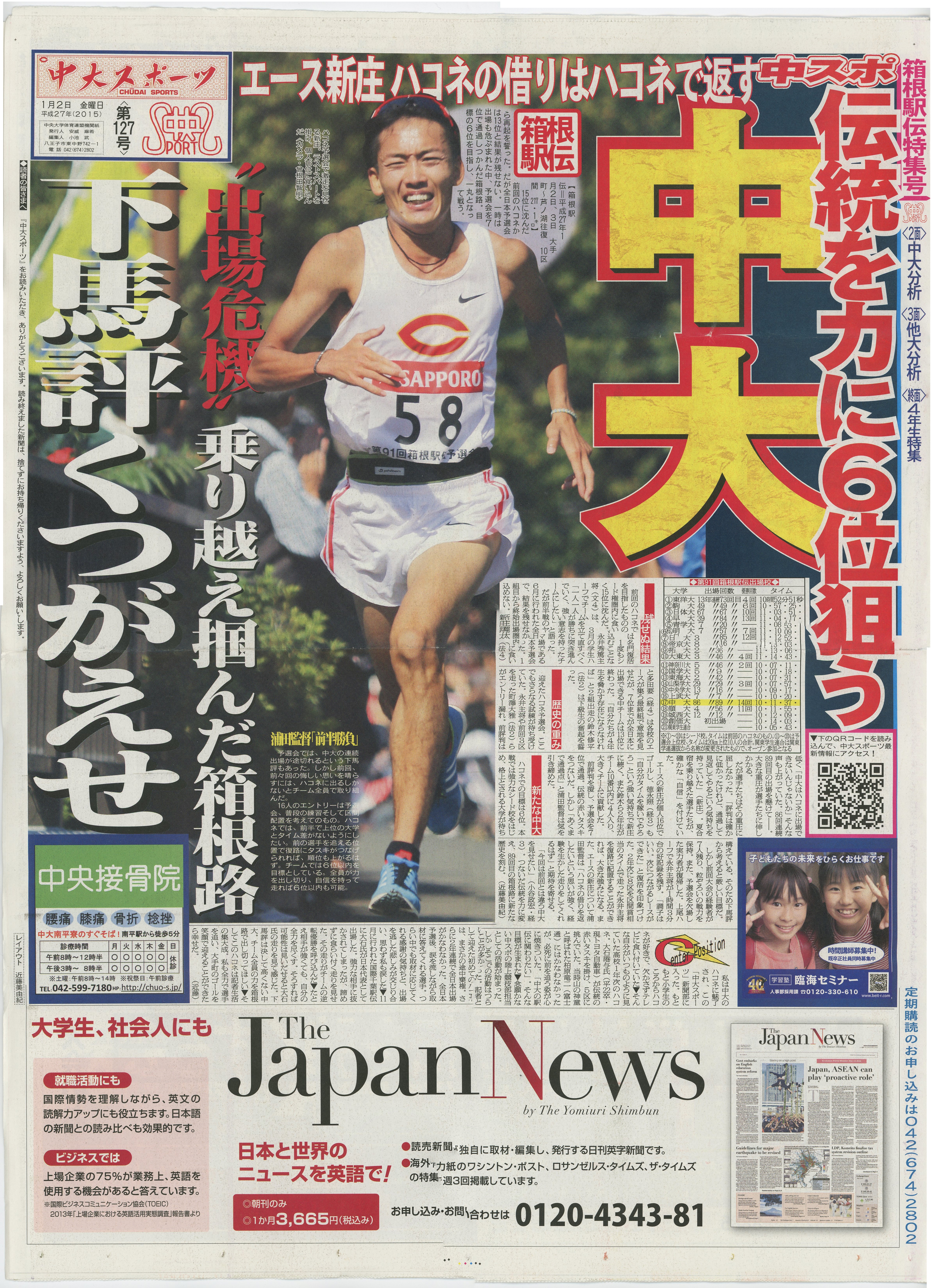
Others:
- A piece on the defunct Kyushu Ekiden, last run in 2013, and longest in the world, at 740km: How the world’s longest relay race ran out of road (The Guardian, November 2013)
[…] The Tokyo Files […]
[…] Chuo University is a frequent participant in the annual Hakone Ekiden college running race. It won the race six times between 1959-1964, but it hasn’t won since 1996. In 2018 it placed 6th overall. See: Watching the Hakone Ekiden: a practical guide to Japan’s biggest race […]